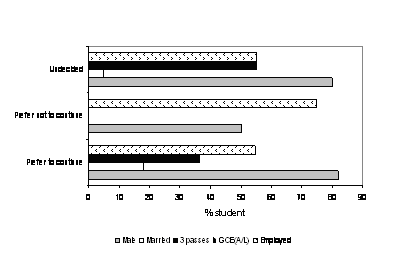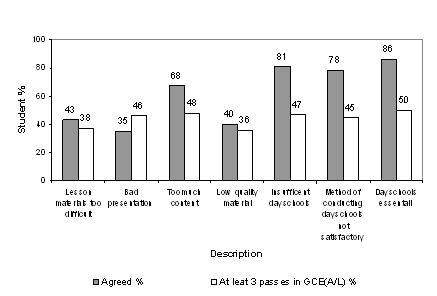Editorís Note: Many students have difficulty in transitioning from the supportive environment of secondary education to the independent and competitive environment of tertiary education. This is especially true where significant courses and programs are available through distance education. This paper explores reasons for student failure and dropout and suggests ways to more effectively transition to the new learning environment by clarifying the roles and expectations of teachers and students.
Factors Affecting on Student Unsuccessfulness
in Engineering Programmes in Distance Education
S.A.M.A.N.S.Senanayake, K.N.H.P.Liyanege, P.R.Dadigamuwa
Abstract:
This study was conducted to ascertain the reasons for unsuccessfulness among students enrolling for engineering (technology) study programme in distance learning conducted by the Open University of Sri Lanka. The profile of students, studentsí awareness about distance learning methodology, reasons for selecting distance learning courses, studentsí appraisal of course delivery, and level of support given by the faculty were studied through a survey conducted among students who follow courses at levels 1 and 2.
According to the study, it was revealed that majority of students who passed the G C E (A/L) examination were found to be either willing to continue or undecided whether to abandon or continue studies. Non-familiarity with distance learning method, lack of time, and high course fees were major reasons for deciding to give up the programme. Language difficulty and difficulty in course material were rated below other factors influencing possible student drop outs. Most students (87%) indicated securing employment and gaining knowledge as their reason for selecting the study programme in distance learning. Only a 13% joined because of persuasion by others.
As far as course delivery is concerned, 86% of students needed more face-to-face teaching reflecting the fact that they have not made up minds to do self-study which is characteristic of distance learning. Further, 78% stated that even the limited face-to-face classes were not conducted to the satisfaction of students.
In conclusion, it was evident that students joined the programme with an understanding of the content of the programme but they seem to find difficulty in coping due to distance learning methods. As far as delivery is concerned there were no major complaints on course material, but a more significant factor was the way faculty, staff and visiting academics conducted limited face-to-face classes. Therefore, making students, as well as all tutors and lectures who undertake to guide the students, thoroughly aware of the distance learning methods at enrolment, is strongly recommended.
Introduction
Any educational or learning process or system in which the teacher is separated geographically and in time from his or her students, and in which the student is separated from other students is defined as distance learning. Distance learning has been thought of as pre-packaged text, audio, and/or video courses taken by an isolated learner with limited interaction with an instructor or other students. However this perspective is changing because of fast developments in information technologies that permit rich interactive distance learning.
On the other hand distance learning is a cost effective method in modern education that facilitates education for large numbers of students who were previously deprived of conventional education for various reasons. Those who go for life-long learning while being employed for their career prospects also find the distance learning much useful to obtain recognised qualifications in their fields of specializations.
In the implementation of a distance learning programme, there are unique problems that stand against achieving programme goals. These problems are related to course type, geographical location, target group, nature of delivery system, evaluation method, and finances. These problems have to be identified and rectified, depending on the specific needs, for optimum performance of any distance learning programme.
There is sometimes a high rate of student drop-outs in distance learning progammes. A number of factors contribute to course non-completion such as feelings of isolation, frustration with the technology, anxiety, confusion, gender, age, educational background, and mode of delivery (Altmann & Armbasich, 1982; Cooper, 1990; Fields and Lemay, 1989). Developing and implementing distance learning packages is more costly than face-to-face teaching. Hence, student numbers have to be large to keep the cost per student at a minimum. However, in countries like Sri Lanka where the potential student population opting for distance learning is low compared to the other countries, even a small student dropout has serious impact on continued operation of a programme of study in distance mode. Therefore, it is important to give serious attention to identifying problems in the distance learning system and providing timely solutions to keep the student interest and retain them until course completion.
Research have shown that most factors affecting successful learning with less stress on the student are unique to a given course and student. However, some common factors have been identified such as level of motivation, feedback and teacher contact, student support and services, alienation and isolation, and lack of experience and training (Galusha, 1998). Knapper, (1988) argues that distance learners are more likely to have insecurities about learning more than traditional students. These insecurities are founded in personal and university related issues such as financing of study, disruption of family life, perceived irrelevance of their studies and lack of support from employers (Sweet, 1986).
Distance learning in Sri Lanka has a history of about 20 years. Many essential features, such as easy accessibility to computer based learning, supplementary materials like audio and video, and teleconferencing, are yet to be introduced to many programmes. Programmes are heavily dependent only on print except for a few courses supported by video and audio.
This paper focuses on factors affecting student unsuccessfulness in distance learning programmes in the Faculty of Engineering Technology of the Open University of Sri Lanka (OUSL). The Open University of Sri Lanka is the only recognised distance education institute in Sri Lanka which awards Certificates, Diplomas, Degrees, and Postgraduate Degrees in natural sciences, engineering, management, education, and humanities. This research was based on a survey carried out among the students of engineering in order to gather information on the student profile and student perception on the course delivery during the academic year 2003/2004.
Case Description
The Faculty of Engineering Technology of the Open University offers two main study programmes viz: Technology (Engineering) programme and Industrial Studies programme. The Technology programme leads to an Advanced Certificate in Technology, Diploma in Technology, and Bachelor of Technology as exit points. This programme is similar to the degree programmes offered by conventional universities and has similar specialisations like civil, electrical, computer, electronic, mechanical, and agricultural and textile. The curricula consists heavy mathematic content and engineering principles. The Industrial Studies programme is an innovative approach to train people so that they could after successful completion actively and efficiently engage in the specific industries with a better understanding of engineering principles, technology, management and other aspects. The specialisations offered under this programme are focused towards an industry for example textile manufacture, Apparel production, and Agriculture.
In this study the sample population was selected from among the students who follow the Technology (Engineering) programme. To enroll in this programme, there is no formal educational requirement. However, those who posses previous qualifications can claim exemptions for certain courses and join the programme at a higher level. The courses in the programme are categorised according to level, ranging from 1 to 6, reflecting the depth of subject matter content, and according to major subject area, for example engineering, mathematics, general, projects, training etc. The courses carry certain credit values that vary according to the work content of the courses, which students can claim on successful completion. In order for a student be awarded an Advanced Certificate, a Diploma or a Degree, a minimum number of total credits and a minimum number of credits specified for different categories of courses at specified levels must be earned by the student. Students specialising in a certain area of engineering need to follow and pass relevant core courses in meeting the credit requirement.
A student is permitted to take maximum of 2.5 credits (equivalent to 1125 study hours) in one academic year. Students are continuously assessed through take-home-assignments, class room tests, and laboratory work where necessary. Students have to reach a minimum standard in each course in the continuous assessment process to be eligibile to sit for the year-end examination in the course.
Since the beginning of the engineering programme of study it has undergone several revisions, all experiencing numerous problems reflecting a large dropout at early stages and thereby reducing the chance of a student being graduated. On the other hand, a few students who graduated took a remarkably long time so that pausing and frustration deprived them of their initial objectives of higher studies and early employment. It has been observed that those come with some middle level technical qualifications do better and complete the programme in a reasonable time frame. The period of study is shortened by virtue of exemptions granted and inherent motivation and orientation to higher studies. Some students who have passed mathematics, physics and chemistry in the General Certificate of Education (Advanced Level) university qualifying examination conducted by the education department have difficulty in successful completion of courses. In spite of this fact, it has been observed that the students with no mathematical background enroll in the programme without much thought of their liking and capabilities, and most of them spend a longer time in the programme.
Methodology
In this study a group of students who failed eligibility to sit the final examination in any one of the level 2 courses was selected. Information was collected through a questionnaire and interviews related to their demographic characteristics, educational background and perception of studies at the Open University. Data analysis related factors in selecting a distance education programme, performance, ratings on course delivery, and satisfaction, to student profiles.
Findings
Unlike conventional classroom learning, it is recognised that in a distance learning system, a large number of students drop out due to its inherent factors. Some reasons are obvious and common, others may be unique and relevant only to a particular group of students or programme. Major factors that influence student unsuccessfulness as determined by the results of this study are presented below.
1. Previous educational background
The student response on the continuation of studies at OUSL was analysed against the gender, performance in GCE (A/L) examination (National University entrance examination conducted by the government), and the present employment. The results are shown in figures 1 and 2.
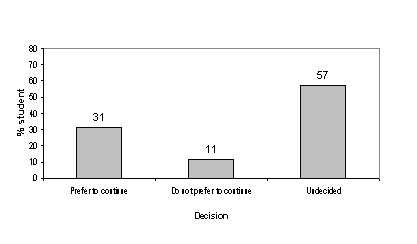
Figure 1: Studentsí decision on continuation of studies
Figure 2: Decisions on continuation of studies according to
gender, marriage, GCE (A/L) qualified, and employment
The students who were undecided on whether to continue or not is characterised by 55% with 3 passes in GCE (A/L), 55% employed, and 80% male. Most of the students with 3 passes in GCE (A/L) were either undecided (55%) or preferred (36%) to continue. No student with 3 passes wanted to stop studies (figures 1 and 2). So it is a reflection that GCE (A/L) qualified students have recognised that the OUSL study programmes are suited for them, but some wonder whether there are some other avenues for them to achieve their goals in education. This was confirmed by the findings through interviews with those students. It is the responsibility of the staff to support them to clear their doubts and encourage them to study with confidence to achieve their goals.
2. Lack of direction by the University
Lack of direction by the teachers has been proved to be one of the major factors contributing to studentsí quandary. Because there is no frequent contact with teachers, students may have trouble in self-evaluation (Keegan, 1986). In the present analysis also it was evident that a significant percentage (54%) of students indicated this as one of the reason for their abandoning of the studies. However, in this particular programme of study and student group factors like unfamiliarity in distance learning, lack of time, and high course fee are found to be major three factors, which contributed to the failure as shown in figure 3.
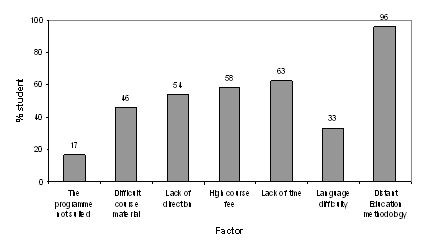
Figure 3: Factors affecting student drop outs
3. Inappropriate selection of a study programme
A distance learning programme should best fit the requirement of the student in every respect. The course structure, schedule of face-to-face sessions, the design of instructional materials; print, video, and audio, subject content and depth should be convenient as much as possible to the students. Otherwise the students instinctively feel that the programme is not for them and invariably forced to leave the studies. The students go by several reasoning as to the selection of a study programme. Some of them lead the student to a wrong selection, as those seem to solve their most felt needs, irrespective of their abilities.
Figures 4 shows that securing employment (56%) is the major factor in deciding to pursue higher studies. Figure 5 finds most of this group are below 35 years of age, unmarried, and males. The second contributing factor was to gain knowledge (31%), out of which about 75% are employed. The remaining 13% said the reason behind the decision to study was persuasion by others (parents and friends). This group was below 35, unemployed and unmarried.
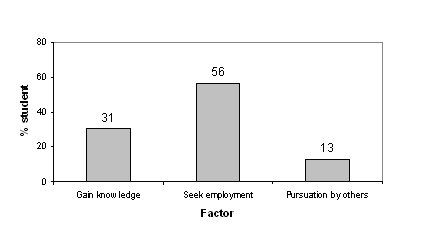
Figure 4: Factors influencing the decision of higher studies
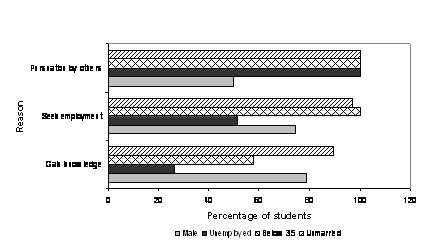
Figure 5: Characteristics of students who responded differently
for reasons of higher studies
4. Course delivery
Efficient course delivery plays a major role for the success of distance learning. When the teacher and the students are separated by physical distance, print, audio, video, and Internet, often in concert with face-to-face communication, is used to bridge the instructional gap. Print is the main and sometimes the only instructional material for the courses in this particular study programme.
According to student feed back on course delivery, most of the students (86%) indicated that face-to-face sessions are essential and should be increased. This outcome is not in agreement with the concept of distance education. Some compelling factors lead the students to select study programmes in distance education without any knowledge or readiness to adjust to the system, so that student commitment and self-motivation are undermined. Such students, who have long experience of conventional face-to-face teaching in their secondary education, expect the same from the distance learning programmes. Therefore, it is necessary to educate students on distance education concepts and methodologies before they enroll in the main programme of study. Also, other facilities such as easy access to Internet; virtual classrooms, CD ROMs, audio and videos can be made available to support the students, to compensate for lack of face-to-face teaching. The argument that highly placed distance education like this needs a lot of resources in terms of technology, human and money cannot be justified with present student numbers so alternative solutions should be provided - for instance more face-to-face sessions, teacher guided discussions etc.
Further, most students (78%) were of the view that the way the face-to-face sessions are conducted is not satisfactory. Frequent complaints that student do not turn up for face-to-face sessions can be contributed to this, as evident from results and they keep away as these did not meet their expectations. Face-to-face contact sessions in distance teaching providing limited opportunity for the students to clarify doubts, and not conventional classroom teaching. Students with little awareness of distance teaching concepts are naturally not satisfied with the way the face-to-face sessions are conducted. On the other hand, students find it difficult to read and understand the subject content of mathematics and engineering disciplines on their own as these students have long experience of conventional face-to-face teaching.
Another significant finding is that 68% of the students said that the content is too much and most did not agree with that the difficulty in lessons and poor presentation.
Figure 6: Student feed back on course delivery
5. Awareness of Distance Education concept and teaching
According to the findings, the student knew the important features of the Open University; such as it is a national university, no necessity of frequent visits to the campus and no formal lectures as in conventional universities. Sixty four percent (64%) of students were also aware of the study system and assessment system. So it is evident that the students were well aware of the concept of distance education and methodologies of teaching. However, in spite of this awareness the failure in the study programme could be contributed to wrong judgment of their capabilities together with lack of commitment, self-motivation and sustained ability to face challenges. According to the study 96% of the unsuccessful students indicated the feeling of isolation in distance education as one of the main reasons that compelled them to give up the courses. This significantly high number of students who do not recognise the concept of distance teaching correctly and its established teaching strategies should be made aware of these facts through intensive counselling at the beginning as well as support throughout the initial year of study. This type of counselling is specially needed in Sri Lanka situation in the light of their highly coached secondary education.
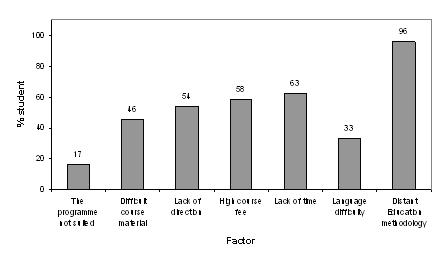
Figure 7: Factors affecting student drop outs
Conclusion
The major contributing factors for the failure of students in the Engineering programme offered through distance learning were the lack of guidance, unfamiliarity of the study system, and difficulty in changing over from conventional classroom teaching to self-learning. Further, students may be guided by irrelevant factors in selecting a most fitting study programme for their capabilities and backgrounds. Students from arts, commerce and biology disciplines in their years of secondary education seek to enroll in the engineering programme, especially computer and electronic disciplines, with the expectation that such qualifications will be well employed in the future. It is of course no barrier for such student to follow the engineering programme and become good engineers, but they should have continuous untiring commitment and self motivation to come to the same status as those who have mathematic background.
As far as faculty is concerned, course materials must be delivered on time and studentsí momentum for learning requires a higher level of support, especially during the transition to distance education. Lack of student support and poor presentation of course content contributed to student failure. Faculty need to focus attention on redesigning the total course delivery system paying the attention to the profile of students. In such an attempt the faculty should devise an efficient means to identify and support students who need special assistance.
References
Altmann H. and Arambasich L. (1982), A study of locus of control with adult student, Canadian Counselor, 16(2), 97-101.
Cooper E. (1990), An analysis of student at Snead State Junior College, Nova University (ERIC Document reproduction Service No. 329298).
Fields L and Lemay J (1989), Factors involved with successful freshman persistence at the community college, Community college Research, 14(3), 31-39.
Galusha J M (1998), Barriers to learning in distance education, (ERIC Document reproduction Service No. 416377).
Knapper, C (1998), Life long learning and distance education, American Journal of Distance Education, 2(1), 63-72.
Keegan D (1986), The foundations of distance education, London, Croom Helm.
Sweet R (1986), Student drop out in distance education: An application of Tintoís model, Distance Educator, 7, 201-213.
About the Authors
S A M A N S Senanayake, PhD (Cranfiled), MSc (Cranfield), B Sc (Engineering) is a Senior Lecturer attached to the Faculty of Engineering Technology, The Open University of Sri Lanka. He graduated from University of Moratuwa, Sri Lanka in Mechanical Engineering in 1985. Dr Sennanayake joined the Open University of Sri Lanka in the same year as an Assistant Lecturer in Mechanical Engineering. In 1996 he obtained his doctorate from University of Cranfield, UK. Dr Senanayake has been engaged in the design and development of distance education programmes in engineering.
Email: nssen@mail.com. Faculty of Engineering Technology, Open University of Sri Lanka, PO Box 21, Nawala, Nugegoda, Sri Lanka.
K N H P Liyanage, PhD(Sheffield Hallam), B.Sc(Hons), MIEE is a Senior Lecturer attached to the Faculty of Engineering Technology, The Open university of Sri Lanka. He obtained his Doctorate from the Sheffield Hallam University in the United Kingdom in Computer Simulation of Manufacturing Systems in 1999. His specialisation area is Industrial Engineering, and current research interests are in modern developments in Production Management, Computer simulation, Change management, Knowledge Management and distance education in engineering.
Email: knliy@ou.ac.lk. Faculty of Engineering Technology, Open University of Sri Lanka, P O Box 21, Nawala, Nugegoda, Sri Lanka.
P.R. Dadigamuwa, Mphil (Open University of Sri Lanka), B.Sc in the field of Materials Engineering. She is a Senior Lecturer attached to the Faculty of Engineering Technology, The Open University of Sri Lanka. She graduated from University of Moratuwa, Sri Lanka in the field of Materials Engineering in 1984 and joined the Open University of Sri Lanka in the same year as Assistant Lecturer in Mechanical Engineering Department. In 1997, she obtained the Master of Philosophy Degree from the Open University of Sri Lanka and became a Chartered Engineer in 2003. She underwent training to design distance education programmes in UK in 1995.
Email: pdadigamuwa@yahoo.com. Faculty of Engineering Technology, Open University of Sri Lanka, P O Box 21, Nawala, Nugegoda, Sri Lanka.
